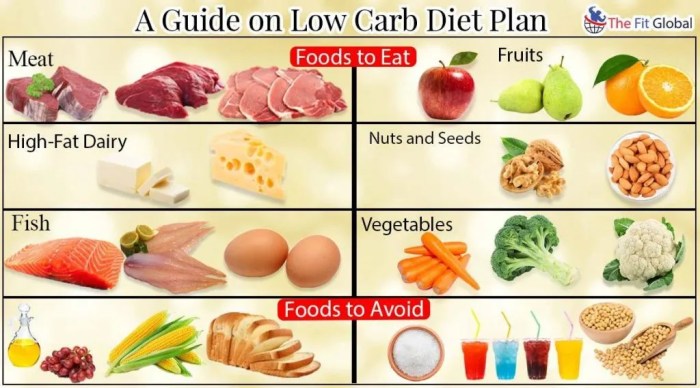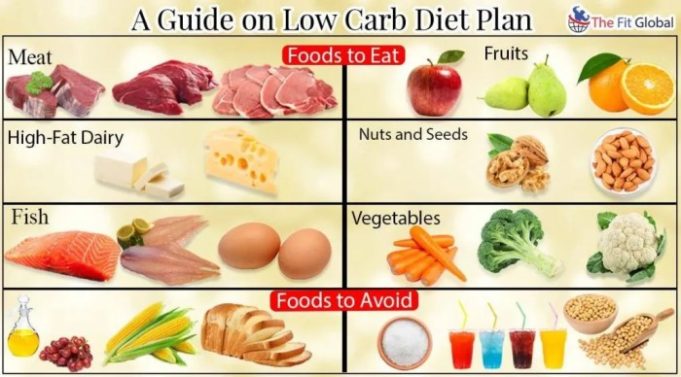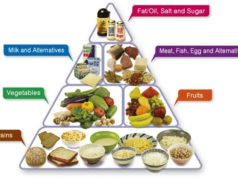How to eat a low carb diet sets the stage for this enthralling narrative, offering readers a glimpse into a story that is rich in detail and brimming with originality from the outset. Low-carb diets have become increasingly popular in recent years, promising weight loss, improved blood sugar control, and other health benefits. But with so many different approaches to low-carb eating, it can be challenging to know where to begin. This guide will provide a comprehensive overview of low-carb diets, covering everything from the basics to practical tips for success.
We’ll delve into the science behind low-carb diets, exploring how they work and the different types available. You’ll learn about the best foods to include in your diet, along with strategies for meal planning and managing cravings. We’ll also address potential risks and side effects, providing guidance on how to mitigate them and ensure a safe and balanced approach.
Understanding Low Carb Diets

Low-carb diets are a popular approach to weight loss and improved health, emphasizing a reduction in carbohydrate intake while increasing protein and fat consumption. This strategy aims to shift the body’s primary energy source from glucose (sugar) to ketones, a byproduct of fat breakdown.
Types of Low-Carb Diets
There are several variations of low-carb diets, each with its unique characteristics and guidelines.
- Ketogenic Diet (Keto): The keto diet is a very strict low-carb diet, aiming for a macronutrient ratio of approximately 70% fat, 20% protein, and 10% carbohydrates. This drastic reduction in carbs forces the body into a state called ketosis, where it begins burning fat for energy. The keto diet is often used for weight loss, managing certain medical conditions, and improving cognitive function.
- Atkins Diet: The Atkins diet is a more flexible low-carb approach that involves four phases: induction, ongoing weight loss, pre-maintenance, and lifetime maintenance. The induction phase is the most restrictive, limiting carbs to 20 grams per day. As weight loss progresses, the diet gradually allows for increased carbohydrate intake.
- South Beach Diet: The South Beach diet emphasizes a balanced approach to low-carb eating, focusing on healthy fats, lean protein, and complex carbohydrates. It encourages the consumption of whole grains, fruits, and vegetables, while restricting refined carbohydrates and unhealthy fats.
Advantages and Disadvantages of Low-Carb Diets
- Advantages:
- Weight loss: Low-carb diets are generally effective for weight loss due to their reduced calorie intake and appetite-suppressing effects.
- Improved blood sugar control: By reducing carbohydrate intake, low-carb diets can help regulate blood sugar levels, making them beneficial for individuals with type 2 diabetes.
- Reduced inflammation: Some studies suggest that low-carb diets may help reduce inflammation in the body, potentially improving overall health.
- Increased energy levels: By switching to fat as an energy source, low-carb diets can provide sustained energy throughout the day.
- Disadvantages:
- Nutrient deficiencies: Restrictive low-carb diets can lead to deficiencies in essential vitamins and minerals, particularly fiber, thiamin, potassium, and magnesium.
- Digestive issues: The high-fat content of low-carb diets can cause digestive problems like constipation, diarrhea, and bloating.
- Kidney stones: In some individuals, low-carb diets can increase the risk of kidney stones due to the increased excretion of calcium in the urine.
- Sustainability: Many people find it challenging to maintain low-carb diets long-term due to their restrictive nature and potential social limitations.
Food Choices on a Low Carb Diet
A low-carb diet emphasizes consuming foods low in carbohydrates and higher in protein and healthy fats. This approach aims to reduce insulin spikes, promote satiety, and potentially aid in weight management. To successfully navigate a low-carb diet, understanding the types of foods to include and exclude is crucial.
Foods to Include
A low-carb diet typically includes a variety of nutrient-dense foods across different food groups. Here’s a breakdown:
- Vegetables: Non-starchy vegetables are the cornerstone of a low-carb diet. These include leafy greens (spinach, kale, lettuce), cruciferous vegetables (broccoli, cauliflower, Brussels sprouts), and others like asparagus, zucchini, and bell peppers. These vegetables are naturally low in carbohydrates and rich in vitamins, minerals, and fiber.
- Proteins: Lean protein sources are essential for maintaining muscle mass and satiety. Excellent choices include:
- Meat: Chicken, turkey, beef, lamb, pork (choose lean cuts)
- Fish and seafood: Salmon, tuna, shrimp, cod, sardines
- Eggs: Whole eggs are a great source of protein, healthy fats, and essential nutrients.
- Dairy: Full-fat yogurt, cheese (choose varieties lower in carbohydrates, like cheddar, mozzarella, and cottage cheese)
- Plant-based protein sources: Tofu, tempeh, lentils (in moderation)
- Healthy Fats: Healthy fats provide energy, support hormone production, and contribute to overall health. Prioritize:
- Olive oil: Use for cooking and dressings.
- Avocado oil: A good choice for high-heat cooking.
- Coconut oil: Versatile for cooking and baking.
- Avocados: A rich source of healthy fats, fiber, and vitamins.
- Nuts and seeds: Almonds, walnuts, chia seeds, flaxseeds (consume in moderation due to their carbohydrate content).
Importance of Nutrient-Dense Foods
Prioritizing nutrient-dense foods over processed options is vital for a successful low-carb diet. Nutrient-dense foods provide a high concentration of vitamins, minerals, and fiber per calorie, contributing to overall health and well-being. They help promote satiety, reduce cravings, and support a balanced diet.
Low-Carb Recipe Examples
Here are examples of low-carb recipes for different meal categories:
Breakfast
- Scrambled Eggs with Spinach and Mushrooms: Whisk eggs with a dash of salt and pepper. Sauté spinach and mushrooms in a pan with olive oil. Combine the cooked vegetables with the scrambled eggs for a hearty and flavorful breakfast.
- Avocado Toast with Smoked Salmon: Mash avocado on whole-grain toast. Top with smoked salmon, a squeeze of lemon juice, and a sprinkle of black pepper. This option provides healthy fats, protein, and fiber.
Lunch
- Tuna Salad with Celery and Cucumber: Combine canned tuna, chopped celery, cucumber, mayonnaise, and a dash of lemon juice. Serve on a bed of lettuce or in a whole-wheat wrap. This salad is packed with protein and healthy fats.
- Chicken Caesar Salad: Grill or bake chicken breast. Toss with romaine lettuce, grated Parmesan cheese, and a homemade Caesar dressing made with olive oil, lemon juice, Dijon mustard, and garlic. This classic salad is a satisfying and low-carb lunch option.
Dinner
- Salmon with Roasted Asparagus and Lemon: Roast asparagus with olive oil, salt, and pepper. Season salmon with salt, pepper, and lemon juice. Bake in the oven until cooked through. This simple and flavorful meal is rich in omega-3 fatty acids, protein, and vitamins.
- Beef Stir-Fry with Broccoli and Bell Peppers: Stir-fry beef with broccoli, bell peppers, garlic, ginger, and soy sauce. Serve over cauliflower rice or zucchini noodles for a low-carb and satisfying dinner.
Snacks
- Hard-Boiled Eggs: A convenient and protein-packed snack.
- Mixed Nuts and Seeds: A handful of almonds, walnuts, chia seeds, or flaxseeds can provide healthy fats and fiber.
- Celery Sticks with Peanut Butter: A classic snack combination that offers healthy fats and fiber.
- Cheese and Crackers: Choose low-carb crackers and pair them with cheese for a quick and satisfying snack.
Meal Planning and Strategies
Meal planning is a crucial aspect of maintaining a low-carb lifestyle. It helps you stay organized, avoid impulsive food choices, and ensure you’re getting the nutrients your body needs.
Sample Meal Plan
A sample meal plan can help you visualize how to incorporate low-carb meals into your daily routine. Here’s a seven-day plan, with portion sizes and food combinations:
Day 1
- Breakfast: 2 scrambled eggs with 1/2 cup chopped spinach and 1/4 cup diced bell peppers
- Lunch: 4 oz grilled chicken salad with 2 cups mixed greens, 1/4 cup chopped cucumbers, 1/4 cup sliced tomatoes, and 2 tablespoons of olive oil and vinegar dressing
- Dinner: 4 oz salmon with 1 cup roasted broccoli and 1/2 cup cauliflower rice
Day 2
- Breakfast: 1/2 cup Greek yogurt with 1/4 cup berries and 1/4 cup chopped nuts
- Lunch: Leftover salmon with 1 cup mixed greens and 1/4 cup sliced avocado
- Dinner: 4 oz ground beef stir-fry with 1 cup chopped vegetables (broccoli, bell peppers, onions) and 1/4 cup soy sauce
Day 3
- Breakfast: 2 slices of turkey bacon with 1/2 cup avocado and 1/4 cup tomato slices
- Lunch: 4 oz tuna salad with 1 cup mixed greens, 1/4 cup sliced cucumbers, and 1 tablespoon of mayonnaise
- Dinner: 4 oz grilled chicken breast with 1 cup steamed asparagus and 1/2 cup cauliflower mash
Day 4
- Breakfast: 1/2 cup cottage cheese with 1/4 cup berries and 1/4 cup chopped nuts
- Lunch: Leftover chicken breast with 1 cup mixed greens and 1/4 cup sliced avocado
- Dinner: 4 oz pork chops with 1 cup roasted Brussels sprouts and 1/2 cup zucchini noodles
Day 5
- Breakfast: 2 eggs with 1/4 cup diced ham and 1/4 cup chopped mushrooms
- Lunch: 4 oz chicken salad with 1 cup mixed greens, 1/4 cup chopped cucumbers, and 2 tablespoons of olive oil and vinegar dressing
- Dinner: 4 oz shrimp scampi with 1 cup steamed broccoli and 1/2 cup cauliflower rice
Day 6
- Breakfast: 1/2 cup Greek yogurt with 1/4 cup berries and 1/4 cup chopped nuts
- Lunch: Leftover shrimp scampi with 1 cup mixed greens and 1/4 cup sliced avocado
- Dinner: 4 oz steak with 1 cup roasted asparagus and 1/2 cup cauliflower mash
Day 7
- Breakfast: 2 slices of turkey bacon with 1/2 cup avocado and 1/4 cup tomato slices
- Lunch: 4 oz tuna salad with 1 cup mixed greens, 1/4 cup sliced cucumbers, and 1 tablespoon of mayonnaise
- Dinner: 4 oz grilled chicken breast with 1 cup steamed asparagus and 1/2 cup cauliflower mash
Meal Prepping and Planning
Meal prepping and planning ahead are essential for staying on track with a low-carb diet.
- Cook in bulk: Prepare large batches of meals on the weekend or during your free time. This allows you to have ready-to-eat meals throughout the week.
- Use leftovers creatively: Don’t be afraid to get creative with your leftovers. You can turn a leftover roast chicken into a salad, soup, or stir-fry.
- Plan your meals in advance: Before you go grocery shopping, create a meal plan for the week. This helps you avoid impulsive purchases and ensures you have all the necessary ingredients on hand.
- Pack snacks: Keep healthy low-carb snacks on hand to avoid cravings and prevent overeating during meals.
Managing Cravings and Pitfalls
Cravings are a common challenge when starting a low-carb diet. Here are some strategies for managing them:
- Identify triggers: Pay attention to what triggers your cravings. Are you more likely to crave sweets after a stressful day? Or are you tempted by sugary snacks when you’re bored?
- Drink plenty of water: Sometimes, cravings are a sign of dehydration. Drinking plenty of water can help to curb them.
- Focus on protein and healthy fats: These nutrients help to keep you feeling full and satisfied, reducing the likelihood of cravings.
- Find healthy alternatives: Instead of reaching for a sugary snack, try a piece of fruit, a handful of nuts, or a few squares of dark chocolate.
- Allow yourself occasional treats: Depriving yourself entirely can backfire. If you have a craving, allow yourself a small, low-carb treat occasionally. This can help you stay on track in the long run.
Health Benefits and Potential Risks: How To Eat A Low Carb Diet
Adopting a low-carb diet can bring about several potential health benefits, but it’s crucial to understand the potential risks and side effects as well. This section delves into both the advantages and disadvantages of this dietary approach, providing you with a comprehensive understanding of its impact on your health.
Potential Health Benefits
A low-carb diet has been linked to various health benefits, including:
- Weight Loss: By reducing carbohydrate intake, you may experience a decrease in appetite and calorie consumption, leading to weight loss. This is because carbohydrates are readily converted into glucose, which can lead to increased insulin levels and fat storage. A low-carb approach can help regulate insulin levels and promote fat burning.
- Improved Blood Sugar Control: Low-carb diets can be particularly beneficial for individuals with type 2 diabetes. By limiting carbohydrate intake, you can stabilize blood sugar levels and potentially reduce the need for medication.
- Reduced Inflammation: Some studies suggest that low-carb diets can help reduce inflammation throughout the body. Inflammation is a natural process that helps fight infection and heal injuries, but chronic inflammation can contribute to various health problems.
Potential Risks and Side Effects
While low-carb diets offer potential benefits, they also come with certain risks and side effects:
- Nutrient Deficiencies: Restricting carbohydrates can limit your intake of essential nutrients, such as fiber, vitamins, and minerals.
- Electrolyte Imbalances: Low-carb diets can lead to electrolyte imbalances, particularly in the early stages. This can result in symptoms such as fatigue, headaches, dizziness, and muscle cramps.
- Kidney Stones: In some cases, low-carb diets can increase the risk of kidney stones. This is because they can lead to an increased excretion of uric acid, which can contribute to stone formation.
- Constipation: Reduced fiber intake can contribute to constipation.
- Nutrient Deficiencies: Limiting carbohydrates can lead to a reduction in the intake of essential nutrients like fiber, vitamins, and minerals. This can be mitigated by incorporating a variety of nutrient-rich foods into your diet.
Addressing Potential Risks
To mitigate potential risks associated with a low-carb diet, consider these strategies:
- Choose nutrient-rich foods: Focus on consuming a wide variety of fruits, vegetables, lean protein sources, and healthy fats to ensure you’re getting adequate vitamins and minerals.
- Stay hydrated: Drink plenty of water throughout the day to prevent dehydration and electrolyte imbalances.
- Gradually transition: Avoid making drastic changes to your diet. Gradually reduce your carbohydrate intake over time to allow your body to adjust.
- Consult a healthcare professional: If you have any underlying health conditions or are considering a long-term low-carb diet, consult with a registered dietitian or healthcare provider. They can help you develop a safe and personalized plan.
Practical Tips for Success
Making a low-carb lifestyle a part of your daily routine requires planning and adjustments. Here are some practical tips to help you succeed.
Grocery Shopping, How to eat a low carb diet
- Focus on Whole Foods: Prioritize fresh produce, lean meats, poultry, fish, eggs, nuts, seeds, and healthy fats. These foods naturally contain fewer carbohydrates and are packed with nutrients.
- Read Food Labels Carefully: Pay attention to the net carbs (total carbs minus fiber). Choose products with lower net carbs and be aware of hidden sugars in processed foods.
- Stock Your Pantry: Keep your kitchen stocked with low-carb staples like almond flour, coconut flour, unsweetened almond milk, unsweetened cocoa powder, and spices. This will make meal preparation easier and more convenient.
Social Events
- Be Prepared: Before attending social events, plan ahead and bring your own low-carb snacks or meals. This will help you avoid temptation and ensure you stay on track.
- Make Smart Choices: Choose grilled or baked options over fried or breaded dishes. Opt for salads with protein and avoid starchy side dishes.
- Communicate with Hosts: If you are dining at someone else’s home, let your host know about your dietary needs. Many people are happy to accommodate special requests.
Travel
- Pack Snacks: Bring along low-carb snacks to avoid relying on potentially unhealthy options at airports or hotels.
- Research Restaurants: Look for restaurants with low-carb options or those that are willing to modify dishes to meet your needs.
- Cook in Your Hotel Room: If you have access to a kitchen or kitchenette, consider bringing some low-carb staples and preparing your own meals.
Adapting Recipes
- Swap Flour: Replace traditional wheat flour with low-carb alternatives like almond flour, coconut flour, or flaxseed meal.
- Use Sugar Substitutes: Consider using natural sweeteners like stevia, erythritol, or monk fruit extract in place of sugar.
- Add More Vegetables: Bulk up dishes with extra vegetables to increase fiber and reduce the overall carbohydrate content.
- Experiment with Flavor: Use spices, herbs, and other natural flavors to enhance taste without adding carbohydrates.
Common Low-Carb Substitutions
| High-Carb Ingredient | Low-Carb Substitution |
|---|---|
| White Rice | Cauliflower Rice |
| Pasta | Zucchini Noodles |
| Bread | Almond Flour Bread |
| Sugar | Stevia |
| Potatoes | Sweet Potatoes |
Long-Term Sustainability
The key to success with any dietary change lies in its long-term sustainability. While a low-carb diet can be effective for short-term weight loss, maintaining it over the long haul requires a mindful approach and strategies to address potential challenges. This section explores how to make a low-carb lifestyle a lasting habit.
Strategies for Maintaining a Low-Carb Lifestyle
Sustaining a low-carb lifestyle involves more than just restricting carbohydrates. It’s about building a sustainable approach that fits your individual needs and preferences.
- Find a Balance: It’s crucial to find a balance between strict adherence and flexibility. While consistent low-carb eating is essential, occasional indulgences can help prevent feelings of deprivation and maintain motivation.
- Gradual Changes: Instead of making drastic changes overnight, gradually reduce carbohydrate intake. This allows your body to adapt and minimizes the risk of feeling overwhelmed.
- Address Plateaus: Weight loss plateaus are common on any diet. If you experience a plateau, try adjusting your calorie intake, increasing physical activity, or incorporating different low-carb foods into your diet.
- Listen to Your Body: Pay attention to how your body responds to different foods. If you experience any adverse effects, consult with a healthcare professional to adjust your diet accordingly.
- Focus on Nutrient Density: Choose low-carb foods that are rich in nutrients, such as leafy greens, vegetables, and lean proteins. This ensures you’re getting the essential vitamins and minerals your body needs.
- Seek Support: Connect with others who are following a low-carb lifestyle. Online forums, support groups, and social media communities can provide valuable insights, motivation, and a sense of camaraderie.
Adapting to Changing Needs
As your body adapts to a low-carb lifestyle, your needs may change.
- Listen to Your Body: Pay attention to your energy levels, hunger cues, and overall well-being. If you feel tired or sluggish, adjust your calorie intake or consider incorporating more complex carbohydrates into your diet.
- Seek Professional Guidance: If you’re struggling to maintain a low-carb lifestyle, consider consulting with a registered dietitian or nutritionist. They can provide personalized guidance and help you develop a sustainable plan that meets your specific needs.
- Embrace Flexibility: As your body adapts to a low-carb lifestyle, you may find that your needs change. Don’t be afraid to adjust your diet as needed to maintain a healthy and sustainable approach.
Concluding Remarks
Whether you’re looking to lose weight, improve your health, or simply explore a different way of eating, this guide will equip you with the knowledge and tools you need to embark on a successful low-carb journey. Remember, the key to long-term success is finding a sustainable approach that fits your individual needs and preferences. With a little planning and effort, you can enjoy the many benefits of a low-carb lifestyle.
User Queries
What are the best low-carb snacks?
Some great low-carb snack options include nuts, seeds, hard-boiled eggs, cheese, and Greek yogurt.
Can I eat fruit on a low-carb diet?
While some fruits are lower in carbs than others, it’s best to limit your intake on a low-carb diet. Berries are a good choice in moderation.
How much water should I drink on a low-carb diet?
Staying hydrated is crucial on a low-carb diet, as it helps prevent dehydration and electrolyte imbalances. Aim for at least 8 glasses of water per day.
A low-carb diet emphasizes protein and healthy fats while limiting carbohydrates. One common question that arises is whether diet soda, like Diet Coke, fits into this plan. It’s important to understand the difference between diet coke and coke in terms of sugar content.
While Diet Coke contains no sugar, it’s still important to be mindful of artificial sweeteners and their potential impact on your health goals.
A low-carb diet focuses on limiting carbohydrates and emphasizing protein and healthy fats. This approach can be effective for weight loss, especially when targeting belly fat. If you’re looking for a specific plan, check out the best diet to lose belly fat female guide, which provides tailored advice for women.
Remember, regardless of the diet you choose, consistency and healthy lifestyle choices are crucial for sustainable results.
A low-carb diet can be a great way to manage weight and improve your overall health. But if you’re breastfeeding, it’s crucial to prioritize getting enough nutrients for both you and your baby. You’ll want to make sure you’re getting enough calories and essential vitamins and minerals.
A balanced approach is key, and you might find resources like best diet when breastfeeding helpful. Ultimately, the best way to eat a low-carb diet while breastfeeding is to work with your doctor or a registered dietitian to create a plan that meets your individual needs.
























